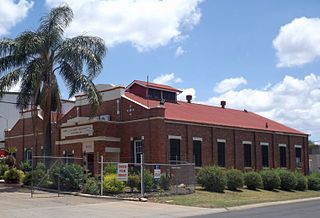Gowrie Junction is a rural locality in the Toowoomba Region, Queensland, Australia. It is north-west of Toowoomba. The town of Gowrie is in the eastern part of the locality. In the 2021 census, Gowrie Junction had a population of 2,242 people.
Wyreema is a rural town and locality in the Toowoomba Region, Queensland, Australia. In the 2021 census, the locality of Wyreema had a population of 2,076 people.

Kingsthorpe is a rural town and locality in the Toowoomba Region, Queensland, Australia. In the 2021 census, the locality of Kingsthorpe had a population of 2,159 people.

Ballard is a rural locality in the Lockyer Valley Region, Queensland, Australia. In the 2021 census, Ballard had a population of 167 people.
Cotswold Hills is a rural-residential locality within Toowoomba in the Toowoomba Region, Queensland, Australia. In the 2021 census, Cotswold Hills had a population of 1,620 people.

Charlton is a rural locality in the Toowoomba Region, Queensland, Australia, located 13 kilometres (8 mi) west from the Toowoomba city centre off the Warrego Highway.. In the 2021 census, Charlton had a population of 107 people.

Wellcamp is a rural locality in the Toowoomba Region, Queensland, Australia. In the 2021 census, Wellcamp had a population of 346 people.

Wilsonton is an urban locality in the Toowoomba Region, Queensland, Australia. In the 2021 census, Wilsonton had a population of 5,891 people.

Harlaxton is a locality in the Toowoomba Region, Queensland, Australia. Historically a rural area, most of the locality is now residential. In the 2021 census, Harlaxton had a population of 2,824 people.

Mount Kynoch is a rural locality in the Toowoomba Region, Queensland, Australia. In the 2021 census, Mount Kynoch had a population of 271 people.

North Toowoomba is a suburban locality in Toowoomba in the Toowoomba Region, Queensland, Australia. In the 2021 census, North Toowoomba had a population of 3,332 people.

Rockville is a residential locality in the Toowoomba Region, Queensland, Australia. In the 2021 census, Rockville had a population of 3,204 people.

Aubigny is a rural town and locality in the Toowoomba Region, Queensland, Australia. In the 2021 census, the locality of Aubigny had a population of 283 people.

Glencoe is a rural locality in the Toowoomba Region, Queensland, Australia. In the 2021 census, Glencoe had a population of 304 people.

Gowrie Little Plain is a rural locality in the Toowoomba Region, Queensland, Australia. In the 2021 census, Gowrie Little Plain had a population of 79 people.

Bergen is a rural locality in the Toowoomba Region, Queensland, Australia. In the 2021 census, Bergen had a population of 85 people.
Cawdor is a rural locality in the Toowoomba Region, Queensland, Australia. In the 2021 census, Cawdor had a population of 420 people.

Gowrie Mountain is a locality in the Toowoomba Region, Queensland, Australia. In the 2021 census, Gowrie Mountain had a population of 222 people.
Cutella is a rural locality in the Toowoomba Region, Queensland, Australia. In the 2021 census, Cutella had a population of 45 people.
Kings Siding is a rural locality in the Toowoomba Region, Queensland, Australia. In the 2021 census, Kings Siding had a population of 15 people.















